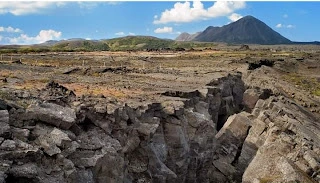Earth is made up of many tectonic plates. They are huge in size. These huge blocks that lie behind the surface of the earth move slowly. It is because of these plates that the continents and oceans are formed on Earth.
Our planet has 7 major tectonic plates:
- African plate
- Antarctic plate
- Eurasian plate
- Indo-Australian plate
- North American plate
- Pacific plate
- South American plate
Apart from these major plates, there are also many smaller plates and microplates. But these do not fall under the definition of major plates.
Many things happen on Earth because of the movement of tectonic plates. For example, mountains are formed on earth because of these plates. These plates are also the cause of volcanoes and earthquakes.
Divergent or rift boundaries form when plates move away from each other. This is exactly what happens if two pieces of paper are moved away from each other to create a gap between them.
And when two plates come close to each other and collide, things like creating mountains and earthquakes happen. This is called convergent boundary. For example, if two pillows are pushed against each other, the junction swells.
Sometimes the plates rub next to each other, but remain separate. This is called a transform boundary. Imagine placing two books side by side, one on top of the other.
The study of tectonic plates is called plate tectonics. It is one of the most important theories in geology. Through this theory we understand how the Earth was formed and changed over time.
History Of Continental Drift
Alfred Wegener was a German meteorologist and geophysicist. One day in 1911 he was doing research in the university library. Then suddenly a scientific research paper came to him. This paper listed ancient fossils of the same plants and animals on both sides of the Atlantic Ocean.
Looking at the list, Wegener was forced to wonder how the same life could have evolved in two separate places separated by thousands of miles of water.
Some scientists of the time believed that there was once a connection between the landmasses on the other side of the Atlantic. But Wegener saw maps of the coastlines of Africa and South America. He could not agree with the scientists. Then Wegener proposed a different idea.
It is possible that the continents were once joined together, then separated at some point. And he then claimed that the process of partition is still ongoing.
From that thought, Wegener came up with his theory of continental drift. At the time, however, his theory was ridiculed as ridiculous.
Then, in the 1950s and 1960s, scientists began to think that Wegener might be right. They found that the fragments of the earth’s crust were slowly moving. And through this process many features of our planet are explained. And continental drift may have made life possible on Earth.
Theory Of Plate Tectonics
Plate tectonics is the theory that states that the Earth’s crust and upper mantle are composed of numerous large and small plates. They stick together tightly, but also constantly change position. Sometimes come to each other. Sometimes they move away from each other.
Tectonic Shift
The movement of plates is called plate motion or tectonic shift. This has been going on for a long, long time. A 2019 study found that plate tectonics began about 2.5 billion years ago and has evolved slowly since then.
Heat Transfer By Convection In Mantles
The Earth is a giant heat engine. When the Earth was forming, it was a giant cloud of dust and gas. These small pieces collide with each other and start getting bigger. These shocks, like many other events in space, produce a lot of heat. That’s exactly what happened when the Earth was formed, and that heat is still trapped inside the Earth.
Also, when the Earth was formed, it was subjected to enormous pressure. As a result of this increase in pressure, the objects inside the Earth are pushed closer together. Just as pressing something causes its heat to rise, this pressure also generates heat inside the earth. Similarly, that heat is also trapped in the earth.
There are also some special types of minerals inside the earth. They slowly break down. This fragmentation results in the release of small particles, which collide with other surrounding objects. This shock also generates heat. This “internal fire” is still burning and generating heat inside the Earth.
Heat flows from warmer to cooler regions. As a result, the Earth’s internal heat flows towards its cooler surface. The way in which heat reaches the earth’s surface from deep inside the earth is called convection. As a result, the hot material of the Earth’s mantle (the middle layer of the Earth) rises, and the cold material falls down. As a result of this wave-like movement (convection), the heat inside the earth gradually reaches the top.
These cold elements are essentially the strongest and strongest plates of the Earth. As the plates cool, they thicken and eventually become so thick that they sink into the Earth’s inner layer (mantle) like molten wax. This causes the Earth to cool and cause motion in the mantle throughout the Earth. That, in a nutshell, is plate tectonics.
But how does all this heat energy move entire plates? One theory is the ‘slab pool’. When a denser oceanic plate (eg, the Pacific plate) sinks beneath a less dense continental plate (eg, the Indian subcontinent plate), they drag the entire overlying plate along with it. This is known as ‘slab pool’.
The plates move very, very slowly. They average only 0.6 inches (1.5 centimeters) per year. However, scientists differ on whether the plates are speeding up or slowing down.
In What Way Do The Plates Change Position?
The plates change their position in 3 different ways.
- Divergent boundary When two plates move away from each other, a divergent boundary is formed. Earthquakes are very common in these boundary regions and here molten rock (magma) rises from the mantle to the surface to form new crust on Earth.
- Convergent boundary or connecting boundary Conversely, where two plates come together, a junction boundary is formed. The collision of plates can form mountains in those places. Or deep trenches may form on the ocean floor. Volcanic ridges are often formed at the point where the boundary forms. Convergent boundaries form continental crust. And if there is any crust under the sea at that place, it destroys it.
- Transform boundary Two plates move past each other at a transform boundary. This will cause cracks and breaks in the crust near the boundary, but will not create new crust like the other two types of boundaries. These cracks cause earthquakes.
How Are Volcanoes Formed?
Plate tectonics profoundly affects our entire planet and all its natural processes. Plate movement causes cracks in the Earth’s crust. Molten rock (magma) rises through these cracks and forms volcanoes.
Fiery lava from volcanoes continuously reshapes the sea floor. Old sea floor is destroyed, new sea floor is created. 72 percent of the Earth’s surface is covered by the ocean floor.
Volcanoes associated with these tectonic plates simultaneously separate the lighter, less dense minerals of the Earth’s mantle from the heavier, denser minerals. The accumulation of these lighter minerals led to the development and growth of continents.
Effects On The Oceans Caused By Plate Movement
This movement of tectonic plates also affected the oceans in various ways and helped create the right conditions for life to exist on Earth. For example, it caused the interaction of hot volcanic rocks with sea water. Ions from these rocks have made the sea salty.
Life evolved in water rich in these ions. And the salinity of human blood is equal to the salinity of sea water, which is a direct result of this process.
Also volcanoes created by plate tectonics have helped increase soil fertility. As a result, plants grow. Food and oxygen are produced. These elements are essential for human and animal life.
Plate Movement And Climate
Plate tectonics also affects the planet’s climate by rearranging the structure of the continents and oceans. Although the shape of the ocean is fixed due to plate movement, its depth and size change somewhat. As a result of this change, warm ocean water near the equator flows to the polar regions of the Earth. This warm water prevents the polar regions from cooling too much, so there is not much difference in temperature between different regions of the world.
Mountains formed as a result of tectonic plate movements also play an important role in absorbing carbon dioxide. They help reduce the amount of carbon dioxide in the air by creating new minerals. This process also increases more or less with the change in temperature. Mountains can be considered as giant thermostats.
Plate Movement And Evolution
The gradual drift of continental landmasses has also played an important role in biological evolution. As a result, a single group of plants or animals splits into two groups at some stage of evolution. Those who are no longer in a reproductive relationship. For example, often when a supercontinent or supercontinent breaks up and new oceans form between its continental parts, new species develop.
Alfred Wegener died in 1930 after being lost in a storm during an expedition to Greenland. If he were alive now, he would surely be very happy to see his theory proven.


